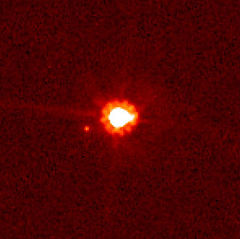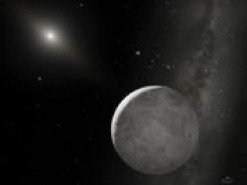Scattered Disk
The scattered disc (or scattered disk) is a distant region of the Solar System, thinly populated by icy minor planets known as scattered disc objects (SDOs), a subset of the broader family of trans-Neptunian objects (TNOs). The innermost portion of the scattered disc overlaps with the Kuiper belt, but its outer limits extend much farther away from the Sun and farther above and below the ecliptic than the belt proper.
The scattered disk is still poorly understood, although prevailing astronomical opinion suggests it was formed when Kuiper belt objects (KBOs) were "scattered" by gravitational interactions with the outer planets, principally Neptune, into highly eccentric and inclined orbits. While the Kuiper belt is a relatively "round" and "flat" doughnut of space extending from about 30 AU to 47 AU with its member-objects locked in autonomously circular orbits (cubewanos) or mildly-elliptical resonant orbits (plutinos and twotinos), the scattered disc is by comparison a much more erratic milieu. SDOs can often, as in the case of Eris, travel almost as great a "vertical" distance as they do relative to what has come to be defined as "horizontal". Orbital simulations show SDO orbits may well be erratic and unstable and that the ultimate fate of these objects is to be permanently ejected from the core of the solar system into the Oort cloud or beyond.
There is an emerging sense that centaurs may simply be objects just like SDOs that were knocked inwards from the Kuiper belt rather than outwards, making them simply "cis-Neptunian" SDOs. Indeed, some objects like (29981) 1999 TD10 blur the distinction, and the Minor Planet Center (MPC) now lists centaurs and SDOs together.[1] In recognition of this blurring of categorisation, some scientists use "scattered Kuiper belt object" (or SKBO) as an umbrella term for both centaurs and member bodies of the scattered disc.
Although the TNO 90377 Sedna is officially considered an SDO by the MPC, its discoverer Michael E. Brown has suggested that because its perihelion distance of 76 AU is too distant to be affected by the gravitational attraction of the outer planets it should be considered an inner Oort cloud object rather than a member of the scattered disk.[2] This line of thinking suggests that a lack of gravitational interaction with the outer planets disqualifies a TNO from scattered disc membership, which would create an outer edge somewhere between Sedna and more conventional SDOs like Eris. If Sedna is beyond the scattered disk, it may not be unique; 2000 CR105, which was discovered before Sedna, may also be an inner Oort cloud object or (more likely) a transitional object between the scattered disc and the inner Oort cloud.
Such objects, referred to as detached, have orbits which cannot be created by Neptune scattering. Instead, a number of explanations have been put forward including a passing star[3] or a distant, planet-sized object[4] (see Sedna).
Eris

Eris (pronounced /ˈɪərɪs/, also /ˈɛrɪs/ as in Greek Έρις),[7] formally designated 136199 Eris and prior to that 2003 UB313 (see minor planet names), is the largest known dwarf planet in the Solar System and the ninth largest body known to orbit the Sun directly. It is approximately 2,500 kilometres in diameter and 27% more massive than Pluto.[8][5]
Eris was first spotted in 2003 by a Palomar Observatory-based team led by Mike Brown but not identified until 2005. It is a trans-Neptunian object (TNO) native to a region of space beyond the Kuiper belt known as the scattered disc. Eris has one moon, Dysnomia; recent observations have found no evidence of further satellites. The current distance from the Sun is 96.7 AU, roughly three times that of Pluto. With the exception of some comets, the pair are the most distant known bodies in the Solar System.[9]
Because Eris is larger than Pluto, its discoverers and NASA called it the Solar system’s tenth planet. This, along with the prospect of other similarly sized objects being discovered in the future, motivated the International Astronomical Union (IAU) to define the term "planet" for the first time. Under a new definition approved on August 24, 2006, Eris was designated a "dwarf planet" along with Pluto and Ceres.[10]
Moon of Eris

In 2005 the adaptive optics team at the Keck telescopes in Hawaii carried out observations of the four brightest TNOs (Pluto, 2005 FY9, 2003 EL61, and Eris), using the newly commissioned laser guide star adaptive optics system.[35] Images taken on September 10 revealed a moon in orbit around Eris. In keeping with the "Xena" nickname already in use for Eris, Brown's team nicknamed the moon "Gabrielle", after the television warrior princess's sidekick. When Eris received its official name from the IAU, the moon received the name Dysnomia, after the Greek demon of lawlessness who was Eris' daughter.
